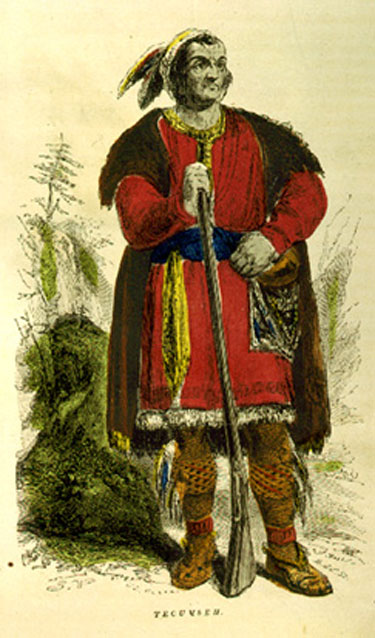The British effectively employed Indian allies in the northern theater of war. In late 1811, Americans had unwittingly helped to forge the Anglo-Indian connection by attacking an extensive intertribal confederation on Tippecanoe Creek where the charismatic Shawnee Tecumseh and his brother Tenskwatawa had established a headquarters at Prophet’s Town. There William Henry Harrison dispersed the Indians and claimed victory, but he had actually driven Tecumseh into the arms of the British.
Indians who cast their lot with either the British or the Americans eventually had reason to regret it.

Alabama Department of Archives and History
The repercussions of that partnership for the United States were profound. Tecumseh and his Indian allies augmented sparse Canadian militia and the handful of regulars Britain could spare from the fight with Napoleon. Moreover, the Anglo-Indian alliance sometimes made the northwestern frontier the scene of vicious warfare. The commander at Fort Dearborn negotiated safe passage for his surrendered garrison, but Indians massacred it anyway, including many wives and children. The threat of merciless Indians panicked William Hull into surrendering Detroit in 1812. In early 1813 after a column commanded by James Winchester was defeated on the River Raisin south of Detroit, Indians slaughtered the American wounded. For the remainder of the war in the northwest, the cry “Remember the River Raisin!” rallied American troops with a grim reminder of this especially brutal aspect of the war.
As the Anglo-Indian alliance in Canada indicates, the War of 1812 was in many respects an Indian war, involving American Indians not only in the north but also in the south. A civil war in the powerful Creek confederation of the Mississippi Territory broke out in 1813 pitting Nativists (called Red Sticks) against Creeks who had accommodated, albeit grudgingly, white culture. At first, it had nothing to do with the Anglo-American conflict, but a Red Stick attack on Fort Mims, where a large number of Creeks as well as American settlers had gathered for protection, transformed the struggle into the Creek War, a full-blown contest between the Red Sticks and American territorial and state militias. At the head of Tennessee militia and volunteers, Andrew Jackson became a frontier hero when he all but annihilated the Red Sticks at Tohopeka (Horseshoe Bend) on the Tallapoosa River on March 27, 1814. In one of the war’s final chapters, the British tried to enlist the survivors of Horseshoe Bend as allies for their campaign in the Gulf of Mexico, but the battered refugees from the Creek War were of little help.
In fact, Indians who cast their lot with either the British or the Americans eventually had reason to regret it. Jackson fought the Red Sticks with the help of allied Creeks, Cherokees, and Choctaws, only to compel both Indian friends and foes to give up a vast portion of their lands in the Treaty of Fort Jackson. The Anglo-Indian alliance in the north came to pieces when Oliver Hazard Perry’s 1813 naval victory on Lake Erie forced British land forces to conduct a rapid withdrawal eastward. William Henry Harrison caught them on the Thames River. Tecumseh was killed in the battle that ensued, which was a major British defeat that reclaimed the northwest for the Americans while shattering the Indian alliance with the British. It also effectively destroyed Tecumseh’s confederation of tribes. Crushed in the south by Jackson and in the north by Harrison, American Indians would be abandoned by their inconstant British friends and were obliged to give up immense areas north of the Ohio as well as east of the Mississippi. It was a prelude to the policy of Indian Removal that Jackson as president would impose on the southern tribes in the 1830s.
Part of a series of articles titled Land Operations in the War of 1812 .
Last updated: August 15, 2017
